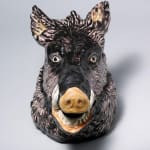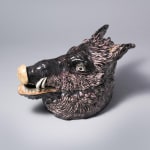

An Extremely Rare Saint Omer Faience Boar Tureen and Cover, Circa 1751-1788
An Extremely Rare Saint Omer Faience Boar Tureen and Cover, modelled life-size the neck and lower mouth forming the tureen, the head which forms the cover with wild staring eyes, snout and tusks, painted in ‘grand feu’ colours in tones of manganese, red and dark browns, the mouth baring teeth and wide open.
An extremely rare ‘Game Form’ or Zoomorphic form. The aperture created at the opening of the mouth would have breathed hot steam from the contents of the inside of the tureen. To hunt a Boar was reserved for the rank of Count on the Continent or the equivalent of an Earl within the United Kingdom.
The Saint Omer manufactory was founded by Georges-Louis Saladin in 1750 after receiving a twenty year privilege to produce faience tablewares as good as Dutch and English delft. In 1751, he was joined by the painter and modeller Jacques Adrien Lévesque who came from Rouen. The manufactory ultimated declared bankruptcy in 1788.
Provenance
The Earl of Belmore CollectionLiterature
An example at the Museum fur Kunst und Gewerbe Hamburg is illustrated in Thomas Rudi, Augenlust und Gaumenfreude: Fayence-Geschirre des 18. Jahrhunderts im Museum fur Kunst und Gewerbe Hamburg, p. 71.
See a similar example in the Bowes Museum, Durham
See another similar example in the Musée Sandelin, Saint Omer
Join our mailing list
* denotes required fields
We will process the personal data you have supplied in accordance with our privacy policy (available on request). You can unsubscribe or change your preferences at any time by clicking the link in our emails.

